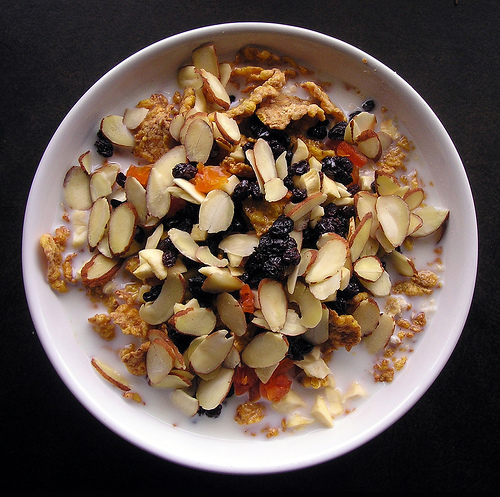
by Michael Shaw
Cereal for breakfast is part of our birthright for Westerners, especially Americans. Of course, there are numerous other options, especially on the weekends, when we maintain a slower, more relaxed pace, but even then, cereal always seems to factor big. But as easy as it is to prepare a bowl of cereal, it’s just as easy to make poor choices, whether it’s choosing a product that has too many chemical additives, too much sugar, or is too expensive. Now there is growing awareness that it’s still wise to avoid wheat/gluten even if you are not gluten-intolerant. In other words, it’s generally best if you can avoid mainly wheat-based cereals whenever possible.
Let’s take a look at some of the most common cereal options in two categories – hot and cold – and consider the best choices that you can make, in terms of health and cost.

Hot cereals
When you think of hot cereals, inevitably one word comes to mind: “oatmeal.” But in terms of what exactly oatmeal can mean these days, you realize we’re a long, long ways from the days when it was pretty much Quaker Oats, period. Now there are fast-cook and slow-cook oatmeals, organic or processed, large cylindrical containers or small, single-serving paper pouches of the stuff.
First let me make a suggestion about the kinds of oatmeal you shouldn’t get: for a couple of years, I was buying a brand of individual serving, paper pouch-style oatmeal that comes six to a box. I bought it because it was often on sale for quite cheap, as low as $2 (U.S.) per box. All you have to do is put it in a bowl, add boiling water and you’re set to go as soon as it cools enough to eat. Not only was it tasty but it was also quite low in sugar, about 4 grams per serving, and also 4 grams of protein. However, when I decided to more carefully investigate the ingredients, the problem was that this oatmeal (in two kinds of flavors, apples, cinnamon and raisins; and pecans and maple) was full of all sorts of chemical additives including aspartame.
I didn’t notice any ill effects from eating this preservative-heavy oatmeal over so many breakfasts, but that doesn’t make it healthy. When choosing based on nutrition facts, doesn’t it make sense to default towards the healthiest choice available? Because when you get used to artificial sweeteners like aspartame and the like, you’re making that sweetness your norm, and that’s not a good default for your taste buds. Choosing as all-natural as possible is always the wisest road to travel.
Instead, whenever possible, I recommend choosing additive-free oatmeal, or other grain-based hot cereal. For oatmeal, I prefer steel-cut over the more chopped-up, quick-cook kind, which tend to get mushier. Steel-cut takes a little longer to cook, but it’s worth it. The generic versions at supermarkets or smaller alternative chains are good, and some stores will offer them in bulk bins, which can be even cheaper still. Other good options are cream of rice, or 7- or 9-grain cereals. The latter may have wheat, just check the ingredients first.
Cold Cereals
Cold cereals are a little trickier- there are more options, of course, but the kinds of cold cereal sold in bins are not particularly reliable in terms of freshness, so you’re going to need to stick to the sealed, boxed or plastic-bagged cereals. Some of the most basic and well-known cereals, including shredded wheat, are obviously not gluten-free. So keep that in mind the next time you shop for cereal. There are puffed cereals, such as rice or millet, which are both gluten-free and also sugar-free, but taste and texture-wise they tend to be a bit too minimal, for some even a bit too much like packing peanuts.
Fortunately, there are many versions of oat-, rice-, and corn-based cereals available. I like Corn Chex and Rice Chex, and each will have its generic and therefore much more affordable options in most stores. It should be said that these are not sugar-free, but at just about 3 grams per 30 g serving, it’s a very low ratio. Cheerios and its generic equivalents are even lower in sugar. They are not officially gluten-free; but unless you’re highly gluten-sensitive, they are very likely quite safe in terms of reactions (but do avoid them if you are highly gluten-sensitive).
Many cereals, meanwhile, do contain wheat: from raisin bran, to Total, to many fiber-oriented products. Cornflakes, which comes in many forms, is both very low in sugar, and for the most part gluten-free, but they do range widely in quality. If it’s affordable, try choosing the organic versions. If not, find the corn flakes with the least ingredients.
There are some great gluten-free cereals out there that use unrefined sugar as a sweetener, such as honey or molasses. Erin Baker’s granola sweetens theirs with honey, while Barbara’s uses unsulphured molasses for its Shredded Spoonfuls and Shredded Oats, though, alas, these latter cereals are not gluten-free.
If you need to be a purist and go completely gluten-free and sugar-free, try the aforementioned puffed cereals from rice or millet. The very-hard-to-find granolas that are either honey-sweetened or maple syrup-sweetened aren’t technically sugar-free, though they may very well be refined sugar-free, which is certainly an improvement.
The important thing is to decide what your priorities are and then choose based on those priorities. Pay close attention to all ingredients, and if you manage to find a completely or near-sugar-free cereal that isn’t sweet enough for you, try adding natural stevia sweetener.
(Michael Shaw is a freelance writer who covers health and vegetarian eating, and has a particular passion for healthy alternative products becoming more available to the mainstream. He writes about no flour, no sugar diet at no flour no sugar diet.com.)




Thanks for the great tips. I find it difficult to find gluten-free cereals that also taste great. So I stopped eating cereal and substituting with fruits, nuts and yogurt in the morning. I will look for Corn chex and rice chex at my grocery store and see if I like the taste.
Most breakfast cereals come from grains. Even if they are gluten-free, they are not exactly the best option for health.
Also, milk which you need if you consume cereal is not good for you either. Humans are not meant to drink cow’s milk all their lives.
Cream of Rice cereal is a healthy rice-based gluten-free cereal that can be found in Walmart or your closest grocery store. Nature’s Path brand also makes several gluten-free cereals such as Crunchy Maple Sunrise, crispy rice cereal and Koala crisp are gluten-free too.